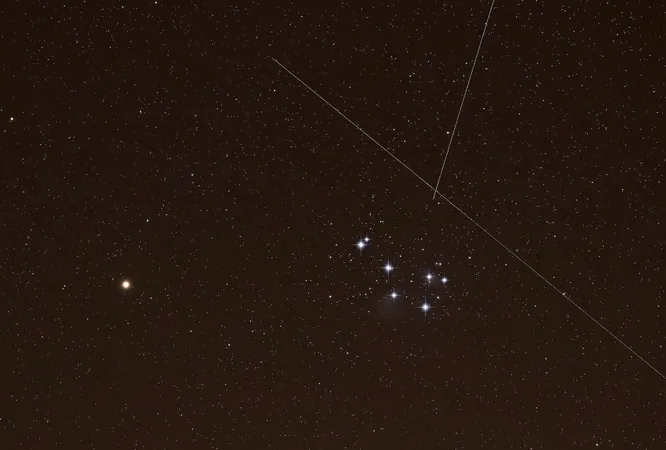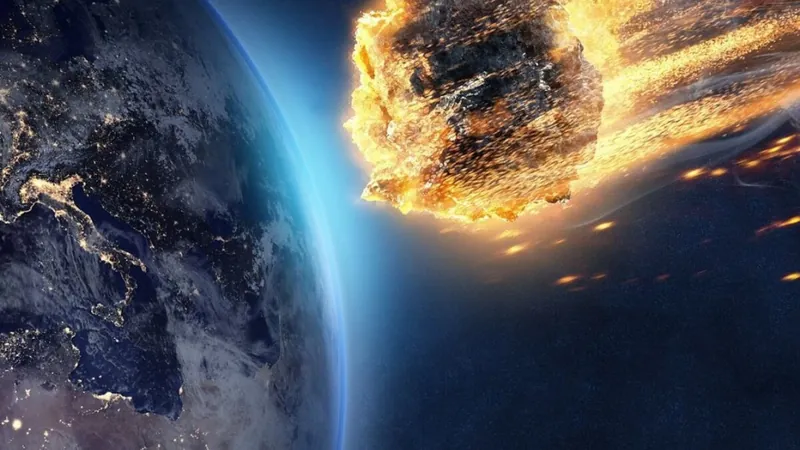
The Stars Are Fading: How Satellite Megaconstellations Are Threatening Our Night Sky
2025-04-04
Author: Wai
Introduction
As humanity's exploration of the cosmos accelerates, the majestic tapestry of stars that once illuminated our nights faces an unprecedented threat. The night sky, a shared canvas of wonder and reflection, has historically been a source of inspiration and a reminder of our cosmic insignificance. However, this celestial beauty is increasingly obscured by an array of artificial lights and an overwhelming number of satellites in orbit, fundamentally altering our connection to the universe.
The Rise of Satellite Megaconstellations
Light pollution has long been a villain, robbing us of the stars' brilliance, but the burgeoning phenomenon of satellite megaconstellations is set to exacerbate this issue. Since 2019, Elon Musk's SpaceX launched Starlink, the first of many megaconstellations intended to provide global internet coverage. From that pivotal moment, the number of satellites in low Earth orbit (LEO) has soared. The Federal Communications Commission has greenlit over 7,000 additional satellites, and the future could see a staggering 500,000 satellites racing around our planet in the coming decade.
Implications for Astronomy
Dr. Jonathan McDowell, an astrophysicist at the Harvard-Smithsonian Center for Astrophysics, emphasizes the profound implications of this rapid expansion: "It’s like many thousands of glinting potato chips running through the night sky." As the number of satellites continues to swell — with plans for tens of thousands more — the serenity of our night sky hangs in the balance.
However, these satellites are not just hindering our stargazing; they are causing real interference for astronomers. As Dr. James Lowenthal from Smith College points out, even professional astronomers are grappling with the challenge of distinguishing genuine astronomical phenomena from satellite reflections. An example of this came when what was initially thought to be an exciting near-Earth asteroid turned out to be a Tesla car launched by Musk, underscoring the potential for confusion in astronomical observations.
Radio Astronomy Under Threat
Moreover, satellites are emitting radio frequencies that scientists rely on for astronomical studies. Recent research highlights that emissions from certain satellites have exceeded international limits designed to protect radio observatories. Alarmingly, new satellites are reported to be emitting 32 times more interference, threatening the very foundations of radio astronomy.
The Complex Debate on Technological Advancements
While some may argue that the technological advancements provided by satellites — such as monitoring greenhouse gas emissions and improving global communication — outweigh the negatives, the reality is far more complex. The balance between the benefits and the long-term dangers of our cosmic "space junk" is a critical concern. Dr. John Barentine, a dark sky consultant, notes that while we wouldn’t currently understand the full breadth of climate change without satellite data, their proliferation could eventually make long-term astronomical studies impossibly difficult.
Environmental Concerns
The environmental footprint of launching so many satellites also cannot be overlooked. Experts like Dr. Connor Barker from University College London caution that while these satellites are designed for a limited life span, their launches produce significant atmospheric pollutants, including harmful nitrogen oxides and black carbon particles. This constant barrage of emissions could have lasting repercussions on our struggling ozone layer and overall air quality.
The Future of Our Night Sky
The situation is becoming dire. Light pollution from satellites is not yet the primary source of brightness in our night sky, but researchers warn that as more satellites are launched, they may contribute significantly to it. Dark sky advocates are vying for more localized policies to combat light pollution from terrestrial sources, but these efforts lag incredibly behind the pace of satellite launches.
Regulatory Challenges
Worryingly, the current regulation framework for outer space is woefully inadequate. The U.N.'s Outer Space Treaty primarily applies to nations, leaving a regulatory void for private enterprises and some of the world's biggest tech companies pursuing commercial endeavors in space. With the regulatory landscape not keeping pace with the interests of these companies, the future of our night sky remains uncertain.
Conclusion
As we stand on the brink of this space race, we must ask ourselves: at what cost do we seek technological advancement? The night sky, once clear and awe-inspiring, is at risk of becoming a glittering expanse of satellites, fundamentally changing our relationship with the cosmos. If we do not take steps to balance innovation with preservation, we may soon be left gazing at a sky dominated by artificial lights, with only fleeting memories of the stars we once cherished.



 Brasil (PT)
Brasil (PT)
 Canada (EN)
Canada (EN)
 Chile (ES)
Chile (ES)
 Česko (CS)
Česko (CS)
 대한민국 (KO)
대한민국 (KO)
 España (ES)
España (ES)
 France (FR)
France (FR)
 Hong Kong (EN)
Hong Kong (EN)
 Italia (IT)
Italia (IT)
 日本 (JA)
日本 (JA)
 Magyarország (HU)
Magyarország (HU)
 Norge (NO)
Norge (NO)
 Polska (PL)
Polska (PL)
 Schweiz (DE)
Schweiz (DE)
 Singapore (EN)
Singapore (EN)
 Sverige (SV)
Sverige (SV)
 Suomi (FI)
Suomi (FI)
 Türkiye (TR)
Türkiye (TR)
 الإمارات العربية المتحدة (AR)
الإمارات العربية المتحدة (AR)